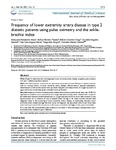Mostrar o rexistro simple do ítem
Frequency of lower extremity artery disease in type 2 diabetic patients using pulse oximetry and the ankle-brachial index
| dc.contributor.author | Mosquera-Fernández, Abián | |
| dc.contributor.author | Balboa-Barreiro, Vanesa | |
| dc.contributor.author | Bellido-Guerrero, Diego | |
| dc.contributor.author | González-Sagrado, Manuel | |
| dc.contributor.author | Vale-Carrodeaguas, María | |
| dc.contributor.author | Veiga-Seijo, Raquel | |
| dc.contributor.author | González-Martín, Cristina | |
| dc.date.accessioned | 2022-12-07T11:11:39Z | |
| dc.date.available | 2022-12-07T11:11:39Z | |
| dc.date.issued | 2021-05-27 | |
| dc.identifier.citation | Abián MF, Vanesa BB, Diego BG, Manuel GS, Maria VC, Raquel VS, Cristina GM. Frequency of lower extremity artery disease in type 2 diabetic patients using pulse oximetry and the ankle-brachial index. Int J Med Sci. 2021 May 27;18(13):2776-2782. | es_ES |
| dc.identifier.issn | 1449-1907 | |
| dc.identifier.uri | http://hdl.handle.net/2183/32163 | |
| dc.description | Observational study | es_ES |
| dc.description.abstract | [Abstract] Objectives: To determine the of undiagnosed lower extremity artery disease using the pulse oximetry in a type 2 diabetic population sample. Methods: Observational, cross-sectional, descriptive study that included 594 type 2 diabetic patients, with no previous history of lower extremity artery disease. Medical history, physical examination, determination of the ankle-brachial index (portable Doppler) and measurement of oxygen saturation in upper and lower extremities (pulse oximeter) were performed. Results: Frequency of lower extremity artery disease determined by ankle-brachial index was 18.4%. No significant correlations were detected between oxygen saturation and the ankle-brachial index except for the relationship between ankle-brachial index vs. oxygen saturation at 30 cm lower limb elevation vs. the supine position at no elevation (0 cm) in subjects under the age of 40. Pulse oximetry showed little diagnostic value in the screening of lower extremity artery disease. A relationship between lower extremity artery disease and age has been found. Its diagnosis was associated with a lower body mass index and lower systolic blood pressure in the lower extremities and higher in the upper extremities. Conclusions: We conclude that pulse oximetry is not useful in the screening for asymptomatic lower extremity artery disease in type 2 diabetics. | es_ES |
| dc.language.iso | eng | es_ES |
| dc.publisher | Ivyspring | es_ES |
| dc.relation.uri | https://doi.org/10.7150/ijms.58907 | es_ES |
| dc.rights | Creative Commons Attribution 4.0 International License (CC-BY 4.0) | es_ES |
| dc.rights.uri | http://creativecommons.org/licenses/by/4.0/ | * |
| dc.subject | Diabetes | es_ES |
| dc.subject | Pulse oximetry | es_ES |
| dc.subject | Lower extremity artery disease | es_ES |
| dc.title | Frequency of lower extremity artery disease in type 2 diabetic patients using pulse oximetry and the ankle-brachial index | es_ES |
| dc.type | info:eu-repo/semantics/article | es_ES |
| dc.rights.access | info:eu-repo/semantics/openAccess | es_ES |
| UDC.journalTitle | International Journal of Medical Sciences | es_ES |
| UDC.volume | 18 | es_ES |
| UDC.issue | 13 | es_ES |
| UDC.startPage | 2776 | es_ES |
| UDC.endPage | 2782 | es_ES |
Ficheiros no ítem
Este ítem aparece na(s) seguinte(s) colección(s)
-
GI-GIRS - Artigos [94]






